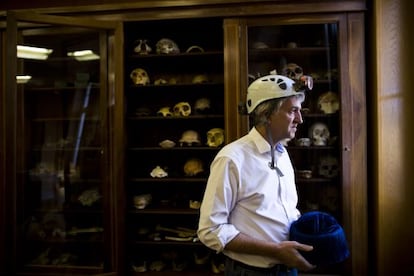“Spain virtually invented paleontology”
Fresh from the discovery that an Atapuerca specimen has the oldest human DNA in the world, site director Juan Luis Arsuaga on success and his frustrated ambition to be a caveman

When Juan Luis Arsuaga was growing up in the 1960s, he says he wanted to be a caveman, which probably explains why he studied paleontology. He later joined the team excavating the cave complex at Atapuerca, near Burgos. Along with colleagues José María Bermúdez de Castro and Eudald Carbonell, he has just published the oldest DNA sequence in the world, taken from a 400,000-year-old femur found at Atapuerca and which suggests a link between Europe's hominids of the time and the little-known Denisovans, who until now were believed to have lived in southwestern Siberia, rather than the more widespread Neanderthals.
Question. What was Femur 13 like?
Answer. Its owner was a tall, well-built man. But these people were very different to the Cro-Magnon, who had a strong sense of identity, a very strong sense of self-esteem.
Q. So the Cro-Magnon went from Darwin straight to Freud?
These people were meant to be from Siberia, now we know that they were in Burgos beforehand"
A. It seems like it. They were the first to paint the caves at Altamira
[a cave complex near Santander] and they used to adorn themselves. That said, the people who lived 400,000 years ago weren't exactly stupid.
Q. Compared to?
A. To their competitors at the top of the food chain: lions, and other predators.
Q. What makes you say that?
A. They moved in packs and were well-organized.
Q. So they liked to party?
A. The other animals certainly respected them.
Q. How did this bone come to be discovered?
A. It was in 1994. But until now we didn't have the technology to determine the DNA sequence. Until two years ago, this wasn't possible.
Q. What was so surprising about what you learned?
A. That this wasn't from a Neanderthal. It is from an older species, the oldest we could compare it to is the Denisovans, who we thought were from Siberia, but we now know that they started out in Burgos, and not the other way round.
Q. So this has set the cat among the pigeons...
A. It is a small light amid a great deal of darkness. Let's see what happens now. We want to extract more DNA from these bones and try to extract the nuclear DNA sequence, not the genome; that is still a dream. But the nuclear sequence will not tell us much more. We have the surname, the nuclear DNA would give us information about physical characteristics. The German laboratory that has worked with us on this, run by Svante Pääbo, along with the scientist in charge of the project, Matthias Meyer, didn't expect this to make such a splash. They say that only the discovery of extra-terrestrial life would have made more headlines.
Q. Will we see older remains discovered?
What caused the death of those 28 people whose bones we found?"
A. I can't imagine that happening. For me, all that remains now is to discover the yeti. Maybe even that wouldn't surprise me; after all, if there were horses there, then there would be men. Global warming means that something will be discovered sooner or later.
Q. So he'll turn up, and we'll have become extinct. Will Femur 13 become more famous than "Miguelón," the first European you found at Atapuerca?
A. I hope not, because I like morphology. So until some frozen remains are found, all we know is what we glean from bones, how they walked, what their pelvis is like... Miguelón is the champ, he's kept in a display cabinet, and his DNA is no use.
Q. How long have you been into paleontology?
A. I wanted to be a caveman, but obviously that's not possible. So this is the closest I can get. Although all we do is write things up: report after report.
Q. Is there something you'd like to do before you die?
A. I fear that we won't solve the puzzle that we have uncovered in Atapuerca. What caused the death of those 28 people whose bones we found there?
Q. Maybe you could write a detective novel about it...
A. Something very strange happened. I don't think there was a disaster or an epidemic. The bodies were in good shape; there were no elderly people among them, or children. It was something else, something deliberate. It is a mystery that I will take to the grave with me.
Q. What about the funding for all of this?
A. There have been cutbacks, but we can't complain.
Q. Are you guys the top guns of the scientific community?
A. No. What we do isn't very expensive. It has a big impact, and Spanish paleontology is well regarded internationally. Along with the French, we pretty much invented it. We have an important heritage. We're part of the landscape.
Q. So it's not about egos or anything like that?
A. We don't do this for the money: it's about glory. Now that Mandela is dead, people accept that he had self-esteem, which is really just a nice way of saying that he had an ego. Which is fine. Perhaps that is no longer a sin.
Tu suscripción se está usando en otro dispositivo
¿Quieres añadir otro usuario a tu suscripción?
Si continúas leyendo en este dispositivo, no se podrá leer en el otro.
FlechaTu suscripción se está usando en otro dispositivo y solo puedes acceder a EL PAÍS desde un dispositivo a la vez.
Si quieres compartir tu cuenta, cambia tu suscripción a la modalidad Premium, así podrás añadir otro usuario. Cada uno accederá con su propia cuenta de email, lo que os permitirá personalizar vuestra experiencia en EL PAÍS.
¿Tienes una suscripción de empresa? Accede aquí para contratar más cuentas.
En el caso de no saber quién está usando tu cuenta, te recomendamos cambiar tu contraseña aquí.
Si decides continuar compartiendo tu cuenta, este mensaje se mostrará en tu dispositivo y en el de la otra persona que está usando tu cuenta de forma indefinida, afectando a tu experiencia de lectura. Puedes consultar aquí los términos y condiciones de la suscripción digital.
Últimas noticias
Most viewed
- Reinhard Genzel, Nobel laureate in physics: ‘One-minute videos will never give you the truth’
- Pablo Escobar’s hippos: A serious environmental problem, 40 years on
- Charles Dubouloz, mountaineering star, retires at 36 with a farewell tour inspired by Walter Bonatti
- Why we lost the habit of sleeping in two segments and how that changed our sense of time
- The Florida Keys tourist paradise is besieged by immigration agents: ‘We’ve never seen anything like this’









































